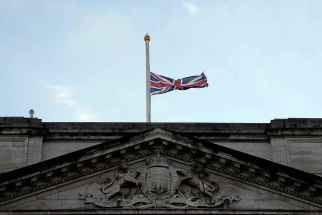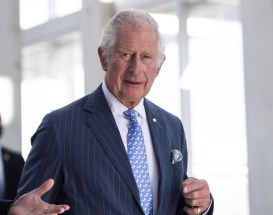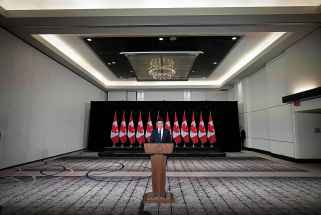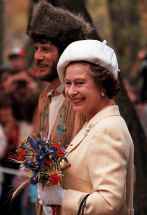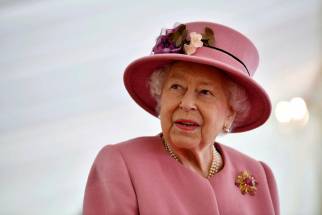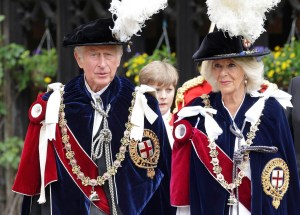Queen Elizabeth II: wisdom, compassion, warmth
Read this article for free:
or
Already have an account? Log in here »
To continue reading, please subscribe:
Monthly Digital Subscription
$0 for the first 4 weeks*
- Enjoy unlimited reading on winnipegfreepress.com
- Read the E-Edition, our digital replica newspaper
- Access News Break, our award-winning app
- Play interactive puzzles
*No charge for 4 weeks then price increases to the regular rate of $19.00 plus GST every four weeks. Offer available to new and qualified returning subscribers only. Cancel any time.
Monthly Digital Subscription
$4.75/week*
- Enjoy unlimited reading on winnipegfreepress.com
- Read the E-Edition, our digital replica newspaper
- Access News Break, our award-winning app
- Play interactive puzzles
*Billed as $19 plus GST every four weeks. Cancel any time.
To continue reading, please subscribe:
Add Free Press access to your Brandon Sun subscription for only an additional
$1 for the first 4 weeks*
*Your next subscription payment will increase by $1.00 and you will be charged $16.99 plus GST for four weeks. After four weeks, your payment will increase to $23.99 plus GST every four weeks.
Read unlimited articles for free today:
or
Already have an account? Log in here »
Hey there, time traveller!
This article was published 08/09/2022 (1194 days ago), so information in it may no longer be current.
This much is certain: we will not see the likes of her again.
The passing of Queen Elizabeth II on Thursday, at age 96, is so much more than the end of an era; hers was a reign that spanned numerous eras, multiple generations and so many shifts in societal, economic, technological and cultural trends and values that the world in which she ascended to the throne would be virtually unrecognizable to anyone born beyond the halfway point of her 70-plus years as Britain’s monarch.
Buckingham Palace issued a release early Thursday stating the Queen was under medical supervision at Balmoral Castle in Scotland, where she had been in residence since July, and that her physicians were concerned about her health. Members of the royal family, including all four of the Queen’s children and Princes William and Harry, were either at or en route to the castle.
The news of her passing, shortly after 12:35 p.m. CDT, came as no surprise, as the Queen’s health had reportedly been declining in recent weeks. But the outpouring of sadness and sympathy from across Britain and around the world was immediate and overwhelming.

“It was with the heaviest of hearts that we learned of the passing of Canada’s longest-reigning Sovereign, Her Majesty Queen Elizabeth II,” Prime Minister Justin Trudeau said in a statement posted on Twitter. “She was a constant presence in our lives – and her service to Canadians will forever remain an important part of our country’s history.
“As we look back at her life and her reign that spanned so many decades, Canadians will always remember and cherish Her Majesty’s wisdom, compassion and warmth.”
The end of this second Elizabethan era is bound to intensify discussions about the relevance of — and, in purely practical terms, the fundamental need for — Britain’s royal family. Hers was, after all, a decades-long reign in which attitudes toward the royals shifted from a general acceptance of the monarchy’s divine right to a growing perception of the institution as a colonial blight, a waste of taxpayers’ money and a mostly pointless anachronism.
What will happen to Britain’s monarchy subsequent to Queen Elizabeth II’s passing remains to be seen. But the necessary reflection on the monarch’s life and legacy must surely focus on the contributions of this singular individual whose unwavering commitment to public service provided a steadying hand during numerous waves of troubling times.
The necessary reflection on the monarch’s life and legacy must surely focus on the contributions of this singular individual whose unwavering commitment to public service provided a steadying hand during numerous waves of troubling times.
There were missteps, but relatively few given the duration of the Queen’s reign. Front of mind might be the perceived indifference of Buckingham Palace’s reaction to the death of Princess Diana in August 1997; the Queen remained in Scotland for several days after the fatal accident and was slow to offer a full public acknowledgment of the tragedy, prompting one British newspaper to print “SHOW US YOU CARE” as its front-page headline.
Upon returning to London, the Queen did venture outside the palace gates to examine the massive array of floral tributes laid against the wrought-iron fence, and delivered a televised address that described the royals’ grief at the princess’s passing. It seemed to be enough to turn public opinion back in Her Majesty’s favour.
Mostly, however, Queen Elizabeth II will be recalled by a great many as an exemplary public figure who comported herself with grace and dignity, lent credibility to the institution she represented during times when its usefulness was questioned, and provided those who maintained a belief in the monarchy’s importance with a figurehead fully deserving of their respect and admiration.
By any reasonable measure, one would feel compelled to describe Queen Elizabeth II as “beloved.”
In circumstances in which controversy visited Buckingham Palace during her reign, it tended to swirl around the Queen rather than touch her directly. Even in pop-culture interpretations of her life such as the 2006 feature film The Queen and the ongoing Netflix series The Crown, the portrayal has been largely sympathetic.
By any reasonable measure, one would feel compelled to describe Queen Elizabeth II as “beloved.”
“My heart has been with you all,” she said in June in a message of gratitude in response to ongoing Platinum Jubilee celebrations, “and I remain committed to serving you to the best of my ability.”
And so she did.
History
Updated on Friday, September 9, 2022 12:45 PM CDT: Minor copy edit














